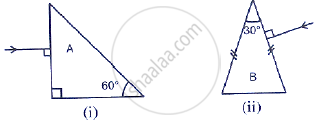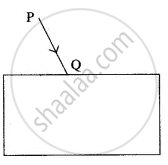Advertisements
Advertisements
Question
After tracing the path of a ray of light passing through a rectangular glass slab for four different values of the angle of incidence, a student reported his observations in tabular form as given below:
| S.No | ∠ i | ∠ r | ∠ e |
| I | 30° | 19° | 29° |
| II | 40° | 28° | 40° |
| III | 50° | 36° | 50° |
| IV | 60° | 40° | 59° |
The best observation is
(A) I
(B) II
(C) III
(D) IV
Solution
Observation III will give the best result because
(i) it has the largest angle of incidence, due to which the lateral displacement between the incident ray and the emergent ray will be maximum.
(ii) for light rays passing through a glass slab, ∠i=∠e and ∠r<∠i.
Hence, the correct option is C.
APPEARS IN
RELATED QUESTIONS
Draw the diagram of refraction of light in the glass slab
When light travels from a rarer to a denser medium, its speed ______.
Fig 4.31 below shows a light ray of single colour incident normally on two prisms A and B. In each case draw the path of the ray of light as it enters and emerges out of the prism. Mark the angle wherever necessary.

Name the material for which the refractive index is found to be maximum.
Define the term refractive index of a medium in terms of velocity of light.
In the diagram below, PQ is a ray of light incident on a rectangular glass block.

How are the angles ‘i’ and ‘e’ related to each other?
Draw ray of light bending towards the normal while passing from glass to water. Label your diagrams.
